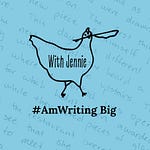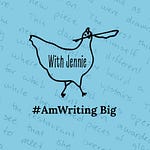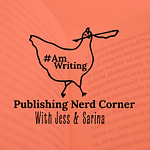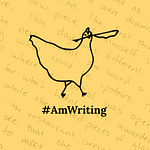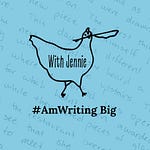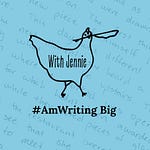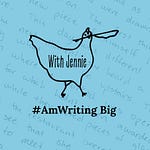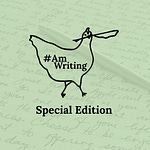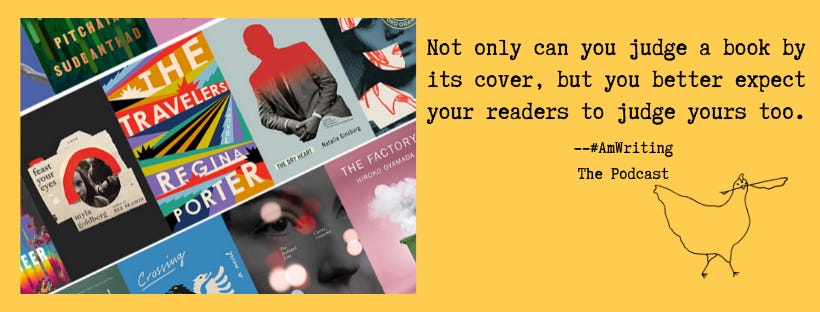
Turns out you should judge a book by its cover, and readers do. Which means authors need to consider that (and not our own taste) when we think about our own covers. This week, we talk about the two things to consider whether you’re an indie working with cover artists or a trad with a publisher and an art department: reader expectations and those now-you-can’t-stop-seeing-the-flowers trends, and it turns into a bit of lesson in heading to the bookstore and making some cover judgments of your own.
Episode links and a transcript follow—but first, have you heard that we recorded our first #SupporterMinis this month? #SupporterMinis are short bursts of advice or inspiration (or maybe commiseration) to punctuate your writing week, which appear in the podcast feeds of our supporters. Supporters also get weekly #WritersTopFives like Top Five Goodreads Secrets for Authors and Top Five Things You Don’t Need to Be a Real Writer. Support us and we’ll do everything we can to support you!
As always, this episode (and every episode) will appear for all subscribers in your usual podcast listening places, totally free as the #AmWriting Podcast has always been. This shownotes email is free, too, so please—forward it to a friend, and if you haven’t already, join our email list and be on top of it with the shownotes and a transcript every time there’s a new episode.
To support the podcast and help it stay free, subscribe to our weekly #WritersTopFive email.
LINKS FROM THE PODCAST
#AmReading (Watching, Listening)
Jess: Running with Sherman: The Donkey with the Heart of a Hero, Christopher McDougall
KJ: Tuesday Mooney Talks to Ghosts, Kate Racculia
More Reading on Book Covers
The 78 Best Book Covers of 2019 from LitHub
9 beautiful book cover design trends for 2019, 99designs
This episode was sponsored by Author Accelerator, the book coaching program that helps you get your work done. Check out their FREE (and epic) upcoming summit on the Business of Book Coaching if you’re intrigued, or visit https://www.authoraccelerator.com/amwriting for details, special offers and Jennie Nash’s Inside-Outline template.
Find more about Jess here, Sarina here and about KJ here.
If you enjoyed this episode, we suggest you check out Marginally, a podcast about writing, work and friendship.
The image in our podcast illustration was compiled by the people at the magnificent LitHub, which you should bookmark and read constantly, and used in the article that’s linked in our shownotes: The 78 Best Book Covers of 2019. I note that I have not read one single one of these books.
Transcript (We use an AI service for transcription, and while we do clean it up a bit, some errors are the price of admission here. We hope it’s still helpful.)
KJ: 00:01 Hello fellow writers. The end of the year is a great time to look back at what filled you up in the past months and for many of us that's not just our writing, but the time we've spent helping others with their work. For some of us that's come out in small ways, but for others it's a calling and an opportunity to build a career doing work you love. Our sponsor, Author Accelerator provides book coaching to authors (like me) but also needs and trains book coaches. And they'll be hosting a free book coaching summit in January for anyone who wants to learn more. If that's got your ears perked up, head to authoraccelerator.com/summit. Is it recording?
Jess: 00:43 Now it's recording, go ahead.
KJ: 00:44 This is the part where I stare blankly at the microphone like I don't remember what I'm supposed to be doing.
Jess: 00:48 Alright, let's start over.
KJ: 00:49 Awkward pause. I'm going to rustle some papers.
Jess: 00:52 Okay.
KJ: 00:52 Now one, two, three. Hey, this is KJ Dell'Antonia and this is #AmWriting, the weekly podcast about writing all the things, be they fiction, nonfiction, proposals, final drafts, pitches, essays, whatever it is that you are working on. We are the podcast about sitting down and getting the work done.
Jess: 01:20 I'm Jess Lahey, I'm the author of the Gift of Failure and a forthcoming book about preventing substance abuse in kids and I am deep in the land of editing right now and you can also find my work at the Atlantic and the New York Times and the Washington Post.
Sarina: 01:33 And I'm Sarina Bowen, the author of 30-odd romance novels and I am revising a book called Heartland, which will come out in the late winter and my revision is due on Monday.
Jess: 01:49 Ouch, but you're going to make it.
KJ: 01:53 I am KJ Dell'Antonia, the author of a novel coming out next summer, as well as How To Be a Happier Parent coming out in paperback next summer and former editor of the Motherlode blog at the New York Times, where I occasionally still contribute, and right now, not in fact in the land of editing, or revising, or anything along those lines. But I will own that my bold declarations regarding NaNoWriMo and trying to finish my current project, I did not. It is not quite the end of NaNoWriMo as we record, but I can guarantee to you that I did not write 50,000 words of a novel during November, but that's okay. I needed to do a lot of thinking, so I could not write. If I had written 50,000 words, it would not have been a good use of my time. Sometimes, it turns out that way.
Jess: 02:45 Well, I said I pulled the rug out from under my NaNoWriMo, anyway. So I've been doing something that was completely unplanned and has been going pretty well, actually. Oh, this is also fun news. I had a meeting with my editor - the same meeting that I had post sort of her taking a look at the first draft of Gift of Failure. And whereas the Gift of Failure meeting was vomit inducing, it was horrible. Some of you have heard this story, but basically suffice it to say it was a nightmare of a meeting with your editor, the very kind of meeting you hope you don't have. Although she's quite a lovely person. This meeting was its exact opposite. It was lovely, it was a love fest, everybody's happy. It was just really, really nice to have a positive meeting to offset the negative meeting that I had after Gift of Failure was turned in. One and one - is that what you say?
KJ: 03:50 I was going to look at a little more positively and say not many writers can have such a ringing guarantee that they have learned.
Jess: 03:58 Well, that's actually something that has been really interesting. I had a huge checklist of basically the what not to do stuff. And it was really nice cause during the meeting she said, 'I could tell that you were trying really hard to not do the things that you did last time.' And I'm like, 'Oh you have no idea. You have no idea how organized I was in my efforts to not make the same mistakes twice.' So that was a ringing endorsement of at least my anal retentive sort of attempts to to do better this time. To learn from my mistakes.
KJ: 04:30 Massive gold star. For learning all the things and we're going to talk about other things that we've learned today. We do have a topic and I'm really excited about it. Today's topic is cover art.
Jess: 04:49 I can fall so deep into this whole...like this topic, especially now since I'm at the point where I get to start sort of like really thinking about this. This can consume me for days.
KJ: 05:01 So we're going to talk about covers when you need to create your own cover. Covers when you're working with a publisher and they are presenting covers to you. Covers internationally. Covers, you know, what it is when you are working with a publisher, what you ought to be thinking about. So let's just start broadly like, what makes a good cover?
Sarina: 05:24 Well, I was thinking about this yesterday, as we were getting ready for this and I had a really good time thinking about it and making notes. And I thought that at the end of the day there were really two things that every author is supposed to think about. Two broad things - and they are, number one reader expectations, followed by (distantly) trends. So when I say reader expectations I mean that all of us, when we walk into a bookstore and we take that first glance at the table in front and maybe your eye comes to rest on a book, I don't know if until you're in this seat where you have to think about it, that you really realize how much information you're getting from that cover just at the first glance. About is that book fiction or nonfiction, is it literary, is it practical, is it a romance, is it for children? You know, you get a lot of information really quickly and, and when it's time for the gut wrenching question of what cover art is going to be on your book, you have to like back out a little and think with your analytical brain about what information you want readers to have.
Jess: 06:44 This is something that when Gift of Failure was in the process of getting its cover the first round of covers really were a clear statement that my publisher wasn't really sure what this book was. And so when we backed up, my agent and I did a really clear conversation about what exactly do you want this book to say about what's inside. And I knew little things, like I wanted people to be able to know what this book was from far away. Like I wanted someone on the other end of a subway car to say, 'Oh, I recognize that book.' But above and beyond that, if you think about what Gift of Failure is, it's a parenting book, but it's an education book. And so there were all these like how do you convey that through a cover design? And it's really a tricky thing. And looking forward to the next book, I don't even know where to start with that, but I love the fact that you have to somehow get all of these messages across graphically. And that's what's so exciting about a cover.
Sarina: 07:49 It is. And we should also say where Gift of Failure ended up as cover art because it's really telling; and it was such a great cover.
Jess: 07:57 Well, and it was a total redesign. And when my agent and I rejected the first set of covers and asked for a redesign, we found the image of a ladder with a broken rung. And then we're like, 'Oh, but what if the ladder was made out of pencils?' So that was kind of a joint effort between me and my agent. So while my agent said (you know, she neve,r hardly ever recommends that an author sort of say, 'Here, look, here's a cover design.') She was very into the idea of us giving them ideas, especially once it seemed like their artists were stuck.
KJ: 08:34 I want to jump on the word rejected. Cause you didn't, cause you couldn't. I have not read your contract, but I can almost guarantee you that that right is not in there.
Jess: 08:48 How about we gently suggested?
KJ: 08:51 But that is something to be aware of if you are in a situation where you're working with a publisher, you don't have control over the cover art. If the publisher said, 'No, no, what we really like for the book, the Gift of Failure is this shot of a Christmas tree with presents on it and gnomes hanging off of it and that's what we're going with. You really got nothing. So when you're in that situation to take like a sort of more diplomatic approach is very necessary. Because every new design really costs them money too, right?
Sarina: 09:32 Right. And in one case, my first novel was women's fiction for Penguin in 2011, basically. And when I first saw the cover, they hired an outside illustrator to make it and I was told upfront that that was sort of an expensive thing to do. And they said, 'Here is your cover.' And I freaked because the cover was a whole bunch of things that did not make sense for this book. It looked vintage to me and the book was straight up contemporary. It was super busy. And I have to tell you, it had comic sans as the font. In black and the rest of the cover was not dark colors. And I just lost my mind there for a minute. But after I freaked out to my agent (and you're allowed to do that) I...
KJ: 10:31 Yes. That's the person to freak out to.
Jess: 10:33 Yeah, absolutely.
Sarina: 10:34 Then I wrote, very carefully, a note about I didn't actually mention how much I loathed with every fiber of my being the imagery on this cover, but rather I explained why the readers we were looking for would not pick up that cover. That it looked too old, it looked too big. You know, because my opinion is not important to this equation, but reader opinion really is.
Jess: 11:01 That's a fantastic point.
Sarina: 11:03 Yeah. That's where you want to go with your angst. Is here's why this would be an error, you know, in a very analytical way.
Jess: 11:12 I had this really cool situation with my publisher where the CEO, President, whatever, my publisher was teaching a class on publishing at a college. And one of the books that he had offered up to the students to do some sample covers for, just to sort of get an idea of how marketing works, one of them was mine. And the student got in touch with me through my website to talk to me about the fact that she had chosen my book as the book that she was working on in this college class on publishing, which was really cool. So that meant that my publisher was thinking about my book, not only from the perspective of 'I'm the publisher of this book and we want people to buy it, but I'm teaching students about marketing using this book.' So it was a really cool opportunity to have lots of perspectives. But also, unique, not many people get that opportunity.
KJ: 12:06 That is very cool. My nonfiction, the How To Be a Happier Parent came back to us the first time with an image of like cartoon parents on a roller coaster with their children. About which there were many, many problems. Among them was that all the parents and children were white. And also being on a roller coaster does not make you a happier parent. I mean, it had its point. I could kind of see where they were coming from, but we did something similar where we went back to them with just talking about how we didn't think it represented the book and ultimately they asked me, 'Well, what do you like?' And this same process, just to jump ahead, it happened to me with the novel, you know, show us some pictures that you like, show us covers that you like, tell us what it is you like about this. They actually did that in the case of the novel before we even went into it. So, in the case of How To Be a Happier Parent, I actually gave them a magazine that I like, it's called Flow, and if anyone ever found Flow and also found the cover of How To Be a Happier Parent, it ended up kind of looking like an issue of Flow. It has a chalkboard, and a floral, it's very trendy to be honest. And I like the cover very much, but it's definitely of its time. And then for the novel this time around I went to the publisher's website and tried to pull covers from their website that I liked.
Sarina: 13:45 Yeah, that was actually really fun to just think about the novel cover with you, KJ.
KJ: 13:51 Yeah, we were all pulling things and it was really great.
Sarina: 13:56 It was super fun. And that's kind of where part two comes into this, which is what trends have to say about what should be on the cover of your book. So one is reader expectations. And with The Chicken Sisters, you know, this is a novel about sisters. It's not a spoiler to say that. So, it's contemporary, it has a family dynamic, there's an element of competition regarding the whole book is about a contest, right? You had all of those things to kind of juggle and play with. And then there's also the trends of what's on the cover of women's fiction right now.
Jess: 14:43 And not just what's on the cover, but what colors. Because it turns out, and I had no idea, obviously there are trends just like in fashion for colors and you can see what colors are trending when you go to your local bookstore.
KJ: 14:56 Oh, you totally can.
Jess: 14:58 It's really interesting. All of a sudden everyone decides teal is the color. Or everyone decides yellow is, it's really fascinating to watch.
KJ: 15:06 Let's hope yellow is the color of 2020 because that's what I ended up with. So The Chicken Sisters went through two cover drafts. So the first cover was very typical of commercial women's fiction. That's commercial, small, the tropes and chicken sisters, just to use the lingo. It's a small town, there's restaurants, there's foodiness, there's women, there's lots of conversation. That's not really a trope. Anyway, the first cover was a picture of two women sitting in a restaurant, talking. And there was nothing wrong with that. Like it was fine, but it didn't really leap.
Sarina: 16:01 It lacked conflict.
KJ: 16:02 It looked like a happy women's, commercial women's fiction book, which it is. But it didn't show that it's a dynamic story. And also, like yours, it looked a little vintage, and it's a very contemporary story. And so we went back and sort of went through it again and talked again about different covers. And the thing that they came back with when they decided to do a complete redesign is such a perfect icon. What they've got is two women's hands pulling at a wishbone, which you guys can see. We will put it up in the show notes, of course. It's all over my Instagram and will continue to be all over my Instagram for the next who knows how long.
Jess: 16:55 Here's a question - did you suggest the wishbone or did they come up with that?
KJ: 16:58 I did not, they came up with it.
Jess: 16:59 It's so good.
KJ: 17:02 It's really perfect.
Jess: 17:04 Because that first one, you're right, it really did look like two friends sitting down and having a cup of tea together. But this is perfect cause there's the conflict, there's the competition, there's the luck. All of that stuff, it's great.
Sarina: 17:17 It's amazing.
KJ: 17:18 And then I suggested (we made it super clear that they are different hands. You can tell by the fact that they've got different nail polish and they look a little different) and then it's got this background of sunflowers, which I love. And apparently floral backgrounds are super trendy, but I love them because the book is set in Kansas and sunflowers are very Kansas. I think what that communicates to readers is just, I don't know what the floral background communicates to readers to be honest. I like it, I pick them up.
Sarina: 17:52 It's just an it item. It's pretty like who doesn't want to look at sunflowers. And we should also say, KJ, that this whole cover art, so gorgeous, is illustrated because that is also a big trend right now. So, in the nineties I read lots of like chicklet novels that had illustrated covers like the Bridget Jones era. And then there was a while there after chicklet kind of had a big moment and then went away that that like illustrated was gone from book cover land because it was like you can't say anything serious underneath an illustrated cover.
KJ: 18:34 The pause here is me trying to remember what commercial women's fiction looked like in the...I guess it would...
Sarina: 18:46 Well, there's photos of like porch swings, and adirondack chairs, and women on beaches with big floppy hats. And all of that is still there. Like Elin Hildebrand has beach covers, but hers are starting to look more illustrated, too.
KJ: 19:03 They're starting to be illustrated pictures of women on beaches in big, floppy hats. And let me just say, I love a good women on a beach and a big floppy hat novel. So, you know, it's a good cover. If there were a beach and hats in my novel, I'd have been all over that.
Jess: 19:19 I have to say all of the books I was going to talk about today. I've done this fun reversal to you know, stuff I don't usually read, the sort of women's romcom stuff and it's all illustrated. You're totally right, I was just looking at the covers.
Sarina: 19:33 Yeah. And that's new. And it's also hitting the romance market pretty hard right now. So like four years ago you couldn't find a single romance novel with illustrations on the cover. It just didn't exist. And you know, everybody knows the history of romance covers with Fabio and like ripped shirts open and people. But a couple obviously screams romance. So people were used to seeing that. And then we hit the 50 Shades era and also self-publishing kind of ripped up all the rules because people didn't have photo shoots at their disposal, so...
KJ: 20:11 They were busily sort of begging their brothers to stand around shirtless and it just wasn't working for whatever reason. Come on, come on, it'd be great for your Instagram.
Sarina: 20:23 It became a stock photo market and there are certain stock photo models that when I see it that I just laugh because they're so overused. Like there's this one model that I call Creepy Eyed Santa Guy. I went for years without a photo of Creepy Eyed Santa Guy because there are a whole bunch of photos of him with a Santa hat on, but lots of photos of him without one. And then my check publisher actually used Creepy Eyed Santa Guy on one of my check editions. So now I do have that guy. But then 50 Shades of Gray came along and this author chose to put like cufflinks and a neck tie on her very stark covers.
KJ: 21:09 And it was self-published. So that was her choice.
Jess: 21:11 I think you mean handcuffs there, Buckaroo.
KJ: 21:15 Oh, that's true.
Sarina: 21:17 No, there were cufflinks.
Jess: 21:19 Oh, were there?
Sarina: 21:20 Yeah.
Jess: 21:21 I only remember the tie and the handcuffs. I don't remember the cufflinks, excellent.
Sarina: 21:25 No, there were like fine menswear stuff on and it. And it was moodily lit so it just looked like, you know, the guy took off his tie cause he had things to do. And that just ushered in what now in romance, people call object covers. And so now, if you see a book cover with a slip on it or just some piece of clothing moodily lit on a dark background, it tells you that that is going to be a very erotic book or have very erotic themes because that one author changed the way that romance novelists looked at cover potentials (in that sub-genre anyway) by her own success made it that way.
KJ: 22:09 Well there were so many things to sort of tease out of that and one of them was your international publisher. But I was thinking about the question of illustratation - You tried an illustrated cover lately? We're talking about reader expectations and I know that recently you had a moment when you felt like the cover that you chose did not meet your readers' expectations.
Sarina: 22:38 Oh yeah.
Jess: 22:39 We want to hear more about that.
Sarina: 22:41 Well, that was just last month and I was spinning off a character. So he was from my Brooklyn series and I had retired him from the hockey team in a book and I was spinning him off into a story about his family's very bizarre security company, like a cybersecurity thing. So I needed readers to know that that beloved character was getting a story and that they were connected. And my wonderful cover artist, she is so talented, made me exactly what I asked her for, which is something a bit trendy, with a bit of a blur to it, really interesting cover for this new series that had an element of suspense. She did exactly what I asked her to. It was gorgeous and the preorders for this book were terrible and I panicked and they just didn't improve and I thought, well, something's just wrong. Like readers really like this guy. They'll like this story, the blurb is good. Like I knew enough to know which things ought to be working and so I woke up six days before the launch - positive that the cover was a problem and I thought, okay, well I'm going to write my poor cover designer an email and say, 'Listen, I've made a big mistake. Do you have any time to help me?' And she said yes. And I bought a photograph from a photographer that day and I sent it over to her and we changed the cover so that you can tell that it's a spinoff from that other series by the typography.
KJ: 24:23 Right. Now it looks like it looks like the other series.
Sarina: 24:27 It does, except the background is dark instead of light and there's no sports imagery on it. But you can tell from the typography and the minute I showed it to people (another author who reads some of my stuff) said, 'Oh, it's a Brooklyn book.' And then I knew exactly at that moment that I was right and that book ended up doing great. It hit USA Today at number 89. It's performed in line, the audio is selling well. Like everything about it did what I had originally expected it to, but I had confused my readers and they did not know what to make of that new cover.
Jess: 25:01 Well and how brave of you. Well, and keep in mind not only how brave of you to make a change at the last second, but making a change at the last second involved a lot of moving parts that a, you couldn't necessarily have anticipated like weird moving parts that that we can go into in just a second. But the other thing is, in terms of expectations, it's okay if your readers expect this to be a Brooklyn Bruiser's novel because they'll pick up that it kinda sorta a little bit is, but it's a new entryway into a whole new series. So, you didn't have to worry too much about people getting confused by it being, but not being, a Brooklyn Bruiser's novel.
Sarina: 25:43 Right. Because that was true. It's just that I had lost them at like maybe it doesn't have anything to do with any of your other books and that was a mistake. Basically I was kind of tired of putting shirtless men on my covers and I wanted something artsy and interesting and it didn't work. Like my readers were not ready. Well, they just weren't there for me to say, 'Hey, my brand today looks different, you have to respect the brand that you've built.' And that's the mistake I made.
KJ: 26:18 Here's a question. Does the illustrated trend extend to Indie and if so, is it a pricey thing to do to have an illustrated cover?
Sarina: 26:27 You know, Indies are a little confused about it, because many of our cover artists are not illustrators. And so I have some friends that have found good illustrators to make this trend work for them. And then there is stock illustration, though. So a good cover artist isn't necessarily going to freehand everything. Like you can find illustration vectors that will contain the imagery that you're looking for and you can move it around however you wish.
KJ: 27:04 Even publishers use that stuff. There is a little bird on the cover of How To Be a Happier Parent that I really loved and wanted to use in other places. And we had a problem because they had licensed it and they had only licensed it for cover use. So we worked it out. But yeah, even publishers use stock illustrations.
Sarina: 27:23 Of course they do.
Jess: 27:24 And publishers will also outsource stuff. There was one of my international editions, the publisher in that country wanted to use the original art from Gift of Failure in the U.S. and apparently my publisher had outsourced that art to someone that didn't necessarily work under that for Harper Collins. And so that art was no longer available because that person, for whatever reason wasn't making it available. So there's all kinds of snags that you can run up against with illustrators and licensing and all that stuff.
Sarina: 27:56 Yeah, I bet that like almost half of U.S. traditionally published books have some element of licensed stock art on them. I see it all over the place.
KJ: 28:11 And now we will all see it all over the place.
Jess: 28:15 Well, I'm in that phase right now where I'm paying a lot of attention to covers because the cover for my next book is going to be really, really tricky. Because for me, I would love it if people would see this next book and identify it somehow with me, or my brand, or my preexisting cover art. How exactly you convey the title (which by the way we think is probably gonna stick) we probably think we're going to stick with the title of The Addiction Inoculation. We had a very specific conversation about this. And there are some worrisome images that you could use.
KJ: 28:50 We've spent some time coming up with the worst possible combination of pencils and The Addiction Inoculation. We've enjoyed it, but you know, it's probably time to give it a rest.
Jess: 29:03 Exactly. So what they end up with, so now I have tastes in covers and they may not necessarily be what's on trend right now. So it's going to be really interesting to see what they come up with. And I'm going to be brainstorming a lot about what possible covers could look like. In fact, I even got an email recently from someone who said, 'You know what, I was in a bookstore recently and I had this idea for you.' And believe me, those things are welcome. I love that.
KJ: 29:30 So Sarina, walk us through creating a cover. As an Indie published author. Like where do you start? Where are you getting this art? Where do you find that person?
Sarina: 29:42 You know, there are 10 or 15 cover artists that my friends and I all use and you can look at somebody's copyright page and see who did their design. So that's one place to start. Or you can even search book cover art.
KJ: 30:03 Yeah. If you search this people definitely pop up. But I personally wouldn't have any way of evaluating them. I guess I could look at their covers because we can judge them by their book covers.
Sarina: 30:15 And I honestly look at designer's websites all the time and I rarely find what I'm looking for cause I'm just super picky now. But the important thing is to find someone who understands the genre because without that key component, it doesn't matter how talented they are. In romance, if somebody showed me a cover without humans on it in some way, I would not be able to take that. And of course these things are really dependent upon the location as well. So all of my German books have flowers on them or other vegetation and they are so pretty. There are just gorgeous. But the first time I saw that flower cover, or actually it was a tree for a different book, I was a little panicked. Like people won't know this is a romance if there's no people on it, it's a tree. How is anyone gonna understand? But that was me just trapped inside my own stereotypical understanding of what I see at the bookstore when I look at a cover and Germans just don't need that, I guess.
Jess: 31:30 The cultural divide can also be really interesting. One of my prettiest covers, I have no idea how it would get any Gift of Failure kind of idea across, it's Korean and it's got this beautiful deer on it. But someone told me that it actually appeals quite well in Korea. So who knows what I know. And by the way, your German covers I think are some of the most beautiful covers out there. I love them so much.
Sarina: 31:53 Well, they were just geniuses with this because the first flower one came out I believe in March or April. And I began seeing it all over Instagram next to pictures of real flowers and it just photographed really well. And the season hit it just right. And yeah, it's pretty great.
Jess: 32:41 The interesting thing is there are some people who also try to hook their website art into their cover art and some people's website art ended up, I'm thinking about Gretchen Rubin's specifically, she worked with a designer who sort of helped to do branding for her all over the place. And that art from the branding company ended up also being her cover art. And so, you know, there's all kinds of convoluted ways this can happen. But some of the most recognizable art out there, I think Gretchen's art is incredibly recognizable from her happiness project. And that was the result of a partnership with a branding company. So anyway, there are lots of ways to to tackle this beast, I suppose.
KJ: 33:28 Yeah. And then when you get your cover art, I would guess as an Indie, you probably want to make sure that you have it licensed so that you can use it in every possible scenario. And if you're working with a publisher, you can ask can I have the elements of the... So for example, I asked for the sunflower background so that I could use it as a background for social media and for for some paper stuff that I wanted. So it doesn't have the cover image, it only has the sunflowers on it. You can take your own cover art, whether it is Indie or publisher driven, and you can you can take a screenshot of a tiny chunk of the color and then just Google, what color is this? And pop the screenshot in there and it'll give you the number. So you'll get this crazy six digit/letter number that signifies that color digitally. And you can go to Canva and make your brand palette with your colors and you should. And then you can use that for everything. You can ask your publisher what your font is and then you'll have to look, maybe Canva and other places have that font. I actually had to buy the font that they used on my title for like $7.99 or whatever. But I bought it and I bought the license so that I can use it on cards and things like that. A publisher might pay for that for you, but in this case the amount that it cost to buy the font was not worth it. And then once you've bought the font, you can upload it to Canva. There's a lot you can do with this stuff once you've got it in hand.
Jess: 35:27 I have these lovely book plates with pencils on them and and that's been a wonderful thing to have and it matches the book. I love it. We are running up against the end of our time, but I wanna make sure we have time to talk about what we've been reading, cause I've been reading a lot.
KJ: 35:43 Are we done with talking about covers?
Jess: 35:45 I don't know. I'm happy to go over and I assume our listeners are happy to go over, but, but there's definitely a lot to talk about and definitely a lot to talk about when it comes to cultural stuff.
KJ: 36:00 Yeah, we didn't talk about like trends in nonfiction and the sort of the big book cover, which is basically nothing but letters on either a background or a background image. Or I was reading some interesting stuff about how there's a new trend for like having the illustration kind of overlap the letters. So that's a neat thing. I don't know. It's just fun to see what's coming and then watch for it. It makes you look at covers differently, even while all the while you're using them in your mind to judge whether or not you would want to read the book. Because the truth is that we do judge a book by its cover.
Jess: 36:39 Well, and you know, it was funny when I was looking at covers for Gift of Failure, I kept sending pictures to my agent of covers that I love. And she'd emailed back and she'd say, 'Yeah, Jess, that book sold like 40 copies.' And I was like, 'I can't help it that my my taste in book covers is a little esoteric, but whatever.' Books, let's do it people, What have you been reading, KJ?
KJ: 37:07 I've actually been reading a lot. It's been a good season for reading for me. So I've been all over Instagram with doing a new thing. I'm doing book chats, which Sarina also does, where I do a little video about the book that I've been reading. It's been a really good reading season, but I'm gonna pull one out. Partly because I like the cover. I just finished Tuesday Mooney Talks to Ghosts. I loved it. And it's got a gorgeous blue cover with this sort of Zodiac looking thing around the type. It's a big book cover in that the type takes up most of the cover, but there is a person on it. Do we think having the person on it sort of signifies fiction? I think it might.
Jess: 37:57 Really? Well, what are you talking about in terms of a person?
KJ: 38:01 This is an illustrated cover but it does have like a silhouette of a person. And now that I'm sort of coming to think of it, it's kind of rare to see silhouettes of people, or any form of people, or body part on nonfiction other than memoir. And I'm sure there are exceptions to this, but I'm just thinking about like what are the subliminal cues here?
Jess: 38:25 That's true, I hadn't thought about that.
KJ: 38:26 Anyway, Tuesday Mooney - it's a little bit ready player one-esque - there's a millionaire with a big game. There is a ghosty element, but it's not very strong. I don't know, it's not like magical realism world. It's very much the real world with a flare of ghostliness, which I like very much. The characters are all incredibly fun. No matter how small the character is in the book, you would totally have a beer with that person. And it really, as a writer, reminded me of what I think of as fun in a book and that I need to focus on those things. Anyway, recommend.
Sarina: 39:11 I can't wait to read it.
Jess: 39:13 Is that it or do you have anymore?
KJ: 39:14 That's it, I'm going to leave the others for other episodes.
Jess: 39:18 Okay. So I have a couple. Sarina, do you mind if I go next?
Sarina: 39:23 You should go next because I don't have a meaningful contribution.
Jess: 39:26 Okay. Well I have a fair number because I've been traveling a fair amount to speak and so that means audio books, obviously, and lots of time on planes. And I was in New York walking all over New York. I got so much great walking done and listening to books. Speaking of great covers. I just finished a book by Christopher McDougall who wrote Born to Run and a couple of other books. You know the one about the, the Mara tribe running this ultra marathon. His new book is Running with Sherman, and Sherman is a donkey. So, of course there is a fantastic picture of a donkey on the cover of this book. And so obviously nonfiction, tells you exactly what the book is going to be about, it's about running with a donkey, and it's great. I loved the book. Christopher McDougall is so good at doing going off on really appropriate tangents, whether that's relationships with animals, mental health. There's a whole side story because of one person in the book about a mental health issue and how animals can affect your mental health. And anyway, so the story of Sherman, this donkey that he rescued from near death and then ended up running a long distance sort of burrow. It's a thing apparently, running with burrows. And it's very, very funny. So that book had a great cover. And then two of the books I listened to, both of which were kind of romcom were illustrated. One was Frankly in Love by David Yoon, and that was a YA. Although, that line between upper YA and adult YA it's such a fine and silly line. But this book was fantastic.
KJ: 41:15 Tuesday Mooney sits on that line, too.
Jess: 41:18 Really?
KJ: 41:18 Totally. It's totally got YA characters, some of them, but it's also got adult characters. Well, you know what Ready Player One sits on that line. I read it, my kids read it.
Jess: 41:29 And this is definitely a first love story and it's a kid finishing high school and going into college kind of thing. But I also learned a ton about Korean culture. The characters are Korean and it was a wonderful love story. And then the other illustrated cover romcom book I read (that I just started today and I'm already completely in love with) is Twice in a Blue Moon by Christina Lauren. And I did not know until Sarina told me that these are two separate authors. I did not realize that they're a team.
Sarina: 42:02 Yeah, Christina and Lauren.
Jess: 42:04 And it sounds like they have what, like 30 books under their belt and they're great. Well, this one so far is fantastic. It's there is an echo of The Accidentals there, Sarina, that's really interesting. And it's just a really fun story to listen to while I'm baking and things like that. And there were also two books that I'm not gonna mention that I wanted to throw across the room in frustration because they didn't stick the landing. And that was incredibly frustrating for me, especially since one of them is in all the airport bookstores because it's a current bestseller at Hudson Books. And I just get so angry. Like this has happened to us many times where I say, 'There's this book, I'm so excited, it's on the best seller list and it's another suspense kind of story. And I get so excited and I get into the characters and then, man, it just falls flat at the end and I get so angry.
KJ: 43:04 Endings are hard. I mean I read something recently, which I will at some point talk about on an episode cause I did end up liking it, but I'm not going to name it right now because this is mildly critical, you know at the end you could see the wheels, you know the machine was cranking. It's hard, I mean I think you could say that about almost any book if you lose your suspension of disbelief for any reason and yet you still keep reading. And sometimes as writers, I think we might lose our suspension of disbelief in ways that we wouldn't as readers. Like something pulls you out and makes you go, 'Oh, I remember them putting this in in chapter four.' And then all of a sudden you're watching the writing and now it's hard not to see the machine moving because you know that there's a machine.
Jess: 43:56 One of the two books that I wanted to throw across the room though, had a clanking machine so loud that I nearly said out loud on the streets of New York, 'That makes no sense and could never happen.' I was so irritated. It was just really, really irritating to me. But I guess I'll leave it at that. You know, I have some other critical things to say, but it's been a really fun reading period because I've realized I've got some dark stuff going on that I'm dealing with personally. And so I'm in that happy place with romcoms and that's really, really fun. Alright, I think we're good people. I think I missed you guys cause cause you did one without me and so I'm so happy to be back.
KJ: 45:07 Before we sign off, let me just remind everybody that if you would like the show notes for this episode, you can always find them at amwritingpodcast.com. If you are interested in getting our top fives for writers, which come out weekly, the most recent one was top five BookBub with secrets for authors. You can also go to amwritingpodcast.com and sign up to be a supporter of the podcast. Do that and the weekly top fives will drop into your mailbox as well as our new mini supporter episodes of which we have so far recorded one. And we're loving building this writerly community, which I might add, you can also check out on Facebook by looking for the AmWriting group.
Jess: 46:02 Okay, until next week everyone, keep your butts in the chair and your head in the game. This episode of #AmWriting with Jess and KJ was produced by Andrew Parilla. Our music, aptly titled unemployed Monday was written and performed by Max Cohen. Andrew and Max were paid for their services because everyone, even creatives should be paid.



